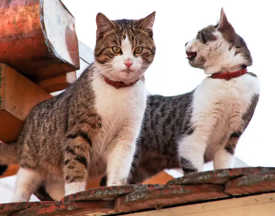SARS-CoV-2 almost certainly originated in an animal. But ever since the virus infected humans the outbreak has been driven by efficient human-to-human transmission, resulting in the current pandemic. The role of animals in the ongoing spread of the virus is negligible.
But does this mean we can ignore animals when it comes to COVID? Definitely not. Many people own animals or come in contact with them. Because of this, they’re right to ask whether pets, livestock or wildlife pose an infection risk.
Furthermore, from a public health perspective it’s important to know whether certain animal species can act as a reservoir for the virus. If the virus can reproduce and survive independently in other species, then it could potentially jump across into humans again later.
In February, a dog in Hong Kong was the first animal reported to be positive with SARS-CoV-2. Most likely the animal had been infected by his owner, who was also diagnosed with COVID. Subsequently, several reports of virus-positive dogs and cats have been published across Asia, Europe and the Americas.
Get The Latest By Email
The susceptibility of dogs and cats has since been confirmed in animal experiments. Furthermore, the observation of infected lions and tigers at a zoo in New York indicates the general susceptibility of feline species to infection. In addition, hamsters, ferrets and several species of monkey were shown to be susceptible in experimental studies, whereas experimental infection of pigs, chickens and ducks failed.
 Cats have been shown to be capable of passing the virus to one another, but it’s not yet known if they could be a viable reservoir for the virus. Bildagentur Zoonar GmbH/Shutterstock
Cats have been shown to be capable of passing the virus to one another, but it’s not yet known if they could be a viable reservoir for the virus. Bildagentur Zoonar GmbH/Shutterstock
The reported cases in cats and dogs were mostly linked to human COVID-19 patients, making it likely that they were infected by humans. But in order to pose a risk or act as a reservoir for the virus, these animals also need to be capable of transmitting it. For some animals this seems possible.
Capability of onward transmission has been demonstrated experimentally for ferrets and cats. In addition, farmed mink have been found to be infected in the Netherlands, Denmark, Spain and the USA.
The mink’s susceptibility was unsurprising given their evolutionary relationship to ferrets. But observations on the farms indicate highly efficient mink-to-mink transmission, making them a potential spreader of the virus as well. Moreover, mink-to-human transmission was discovered on two farms, demonstrating their potential to be a risk to public health.
Two-host reservoirs could develop
Nevertheless, from these observations it’s not certain that cats and mink will become an animal reservoir for SARS-CoV-2.
Cats usually live in a household as a single cat or in small numbers. Whether they can serve as a reservoir depends not only on whether they can infect each other in a household, but also – and even more so – on whether they are capable of infecting cats in other households, for instance while fighting or marking out their territory. This is as yet unknown.
But because cats live in close relation with humans, these two species together could constitute a reservoir. Bovine tuberculosis on the British Isles is an example of where two species together keep a pathogen circulating. Here, transmission among either cattle or badgers alone is unlikely to be efficient enough for either species to sustain the pathogen. But together they can pass the disease-causing bacteria among themselves sufficiently to create an effective reservoir.
A similar phenomenon could be happening with farmed mink and the coronavirus in the Netherlands. All mink farms have been quarantined for months, no minks are being moved between farms, but new infections are still occurring. This seems to point to an infection chain where humans infect mink, mink infect human staff, these staff then go to another mink farm, and the process repeats itself. With quarantine stopping newly infected humans from visiting the farms, infections among the mink should have died out, but if the virus is moving between animals and staff, this potentially explains why it has not.
What about wild animals?
Still little is known about SARS-CoV-2 in wildlife. We assume that the horseshoe bat is the indigenous host of the virus, and we know that fruit bats can be experimentally infected. However, there are many different species of bat, and it is unknown to what extent they can serve as a reservoir for the virus.
Based on observations in domestic cat species and mink, it’s also likely that wild felines and mustelids (the animal family that includes mink, ferrets and weasels) are susceptible. But whether they are able to create a reservoir is unknown, though their solitary lifestyle might make it less likely to happen – to be sustained, the virus needs to be passed around.
Although the role of animals in the pandemic is negligible at the moment, the information available so far indicates that there’s a risk animals could play a more prominent role when transmission among humans has fallen to a low level. Some animals certainly have the potential to pass the virus back to humans in the future if they’re still carrying it.
But work is underway to try and minimise the risk that animals might pose. For instance, to prevent mink from becoming a reservoir, animals on infected farms have been culled. Moreover, surveys in cats and wildlife are being performed to estimate their infection rate.
The Netherlands Centre for One Health is currently studying the potential role of cats in the spread of COVID. It’s working to establish the proportion of infected cats owned by human patients, to quantify direct and indirect transmission of the virus among cats, and to develop a mathematical model to examine the potential contribution of cats to sustained transmission of the virus among humans.
Results from such a study will be helpful for designing interventions to prevent the virus spreading in cats, should they be needed.
About the Author
Arjan Stegeman, Professor of Veterinary Medicine, Utrecht University
This article is republished from The Conversation under a Creative Commons license. Read the original article.
books_pets








